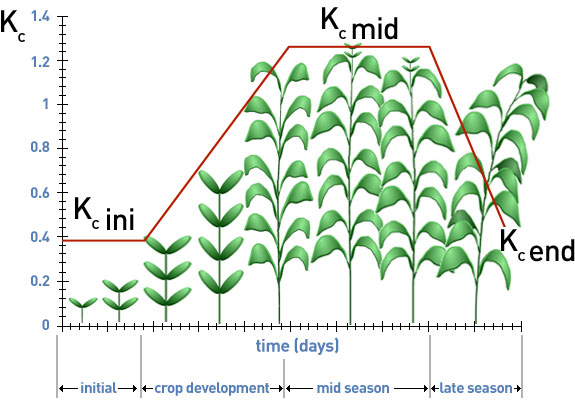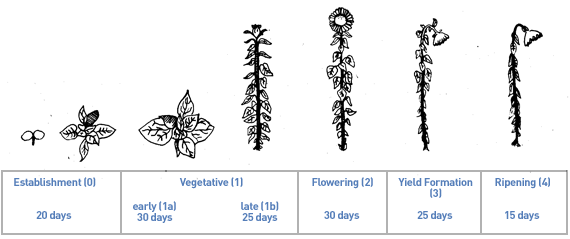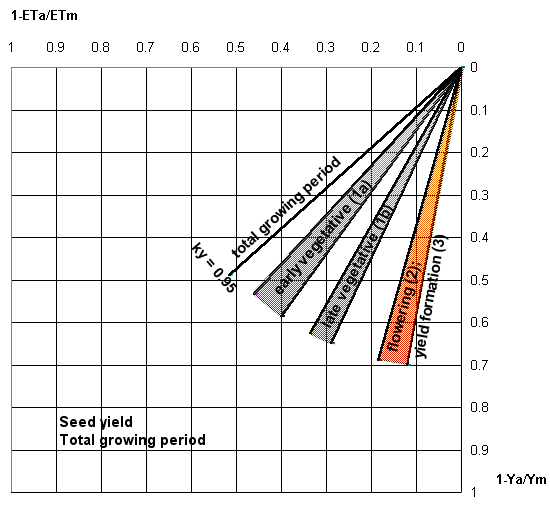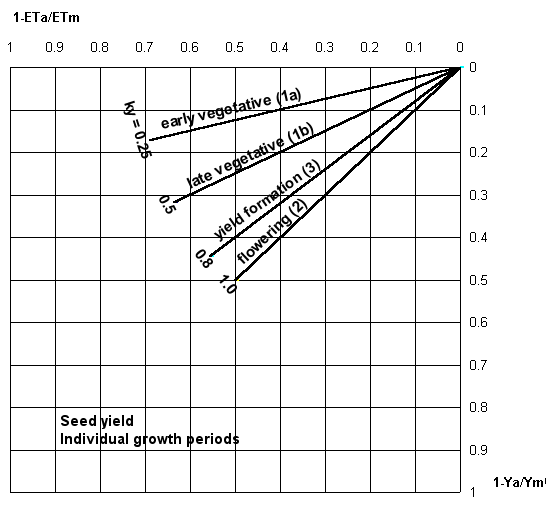Sunflower
This section presents information on water relations and water management of sunflower and provides links to other sources of information.
Crop Description and Climate
Crop Description and Climate
Sunflower (Helianthus annuus) originates from central and north America. Lately its importance as an oil crop has grown and at present it is tile second most important oil crop next to soybean. Total annual world production is some 20.9 million tons of seed from some 18 million ha.(FAOSTAT, 2001).
Sunflower thrives in climates ranging from arid under irrigation to temperate under rainfed conditions, but is susceptible to frost. Mean daily temperatures for good growth are between 18 and 25°C. The total growing period varies from 70 days in parts of Russia where the season is short to 200 days at higher altitudes in Mexico. In the subtropics under irrigation the total growing period is about 130 days. For temperate climates the optimum planting date for early as well as late maturing varieties is between late spring and early summer. Delay in planting results in shortening of the vegetative period and early maturity, causing a decrease in head diameter and seed weight. Sunflower is a short-day plant with a variable response to daylength, but day-neutral varieties exist.
The crop is mainly grown under rainfed conditions on a wide range of soils. Under erratic and low rainfall, a rather deep soil with good water holding capacity is required. Due to its deep root system (2 to 3m) soil water can be explored at great depths. Optimum soil pH is in the range of 6.0 to 7.5, but at lower values liming may be necessary. Fertilizer application is in general 50 to 100 kg/ha N, 20 to 45 kg/ha P and 60 to 125 kg/ha K. The crop is particularly sensitive to boron deficiency.
Optimum plant density is about 60 000 plants/ha with row spacing of about 0.9 m; seed rate is between 4 and 10 kg/ha. Both transplantation and direct seeding are practised.
In the major sunflower growing areas salinity problems are minor; an indication of tolerance to salinity during crop establishment is shown by the emergence percentage of seedlings which is 80 to 100% at ECe 0.70 to 75% at 4.5, 30 to 60% at 9.5, 15 to 55% at 10 and 0 to 25% at ECe 13 mmhos/cm. However, in later growth periods sunflower is moderately tolerant to salinity.

Stages of Development | Plant date | Region | |||||
|---|---|---|---|---|---|---|---|
Crop characteristic | Initial | Crop | Mid- season | Late | Total | ||
Stage length, days | 25 | 35 | 45 | 25 | 130 | Apr/May | Mediterranean., |
Depletion Coefficient, p | 0.55 | >> | 0.5 | 0.8 | 0.45 |
| |
Root Depth, m | 0.3 | >> | >> | 1.3 | - |
| |
Crop Coefficient, Kc | 0.35 | >> | 1.0-1.151 | 0.35 | - |
| |
Yield Response | 0.25 | 0.5 | 0.8 | 1.0 | 0.95 | ||
1The lower values are for rainfed crops having less dense plant population
Water Requirements
Water Requirements
The water requirements of sunflower vary from 600 to 1000 mm, depending on climate and length of total growing period. Evapotranspiration increases from establishment to flowering, and can be as high as 12 to 15 mm/day. High evapotranspiration rates are maintained during seed setting and early ripening period. Percentage of total crop water use over the different growth periods is about 20 percent during vegetative period, 55 percent during the flowering period and the remaining 25 percent during the yield formation and ripening periods. The crop coefficient (kc) is 0.3-0.4 during the initial stage (20 to 25 days), 0.7-0.8 during the crop establishment stage (35 to 40 days), 1.05-1.2 during the mid-season stage (40 to 50 days), 0.7-0.8 during the late-season stage (25 to 30 days) and 0.4 at maturity or harvest.
Water Supply And Crop Yield
Water Supply And Crop Yield
Following figure shows growth periods of sunflower (after Siddigue et al.)

The relationships between relative yield decrease (1 - Ya/Ym) and relative evapotranspiration deficit for the total growing period are shown in the figure below.

This figure shows the relationships between relative yield decrease (1 - Ya/Ym) and relative evapotranspiration deficit for the individual growth periods.

In respect of total yield produced, water requirements of sunflower are relatively high compared to most crops. Despite its high water use, the crop has an ability to withstand short periods of severe soil water deficit of up to 15 atmosphere tension. Long periods of severe soil water deficit at any growth period cause leaf-drying with subsequent reduction in seed yield. With heavy rain or irrigation following an extremely dry period, only a partial recovery occurs.
Severe water deficits during the early vegetative period (1a) result in reduced plant height but may increase root depth. Adequate water during the late vegetative period is required for proper bud development (1b). The flowering period (2) is the most sensitive to water deficits which cause considerable yield decrease since fewer flowers come to full development. Yield formation (3) is the next most sensitive period to water deficit, causing severe reduction in both yield and oil content.
Water Uptake
Water Uptake
In deep soils the root system of sunflower may extend up to 2 to3m but normally, when the crop is full grown, 100 percent of the water is extracted from the first 0.8 to 1.5m (D = 0.8-1.5m). Under conditions when maximum evapotranspiration is 5 to 6 mm/day, the water uptake is affected when about 45 percent of the total avail-able soil water is depleted (p = 0.45)
Irrigation Scheduling
Irrigation Scheduling
For high production, soil water depletion should not exceed 45 percent of the available soil water, particularly during the late vegetative, flowering and yield formation periods. Due to the deep root system, 2 to 4 heavy irrigation applications are usually sufficient when the crop is grown on deep, medium textured soils. In addition a pre-irrigation is given when required. Application should be scheduled during the late vegetative (1b) and the flowering (2) periods. When water supply is limited, water savings can be made during the ripening period (4).
Irrigation Methods
Irrigation Methods
The crop is most suited to surface irrigation, particularly by furrow irrigation, allowing infrequent and heavy application.
Yield
Yield
The giant varieties, grown for poultry feeding and human consumption because of their low oil content, produce seed yields in the range of 0.8 to 1. 5 ton/ha under rainfed conditions. The seeds of dwarf and semi-dwarf varieties contain 25 to 35 percent oil and give a total yield similar to the giant varieties. New Russian varieties with seeds of low hull content have an oil content of up to 50 percent. Under irrigation seed yields of 2.5 to 3.5 ton/ha are commonly obtained. The water utilization efficiency for harvested yield (Ey) for seeds containing 6 to 10 percent moisture is 0.3 to 0.5 kg/m3.
